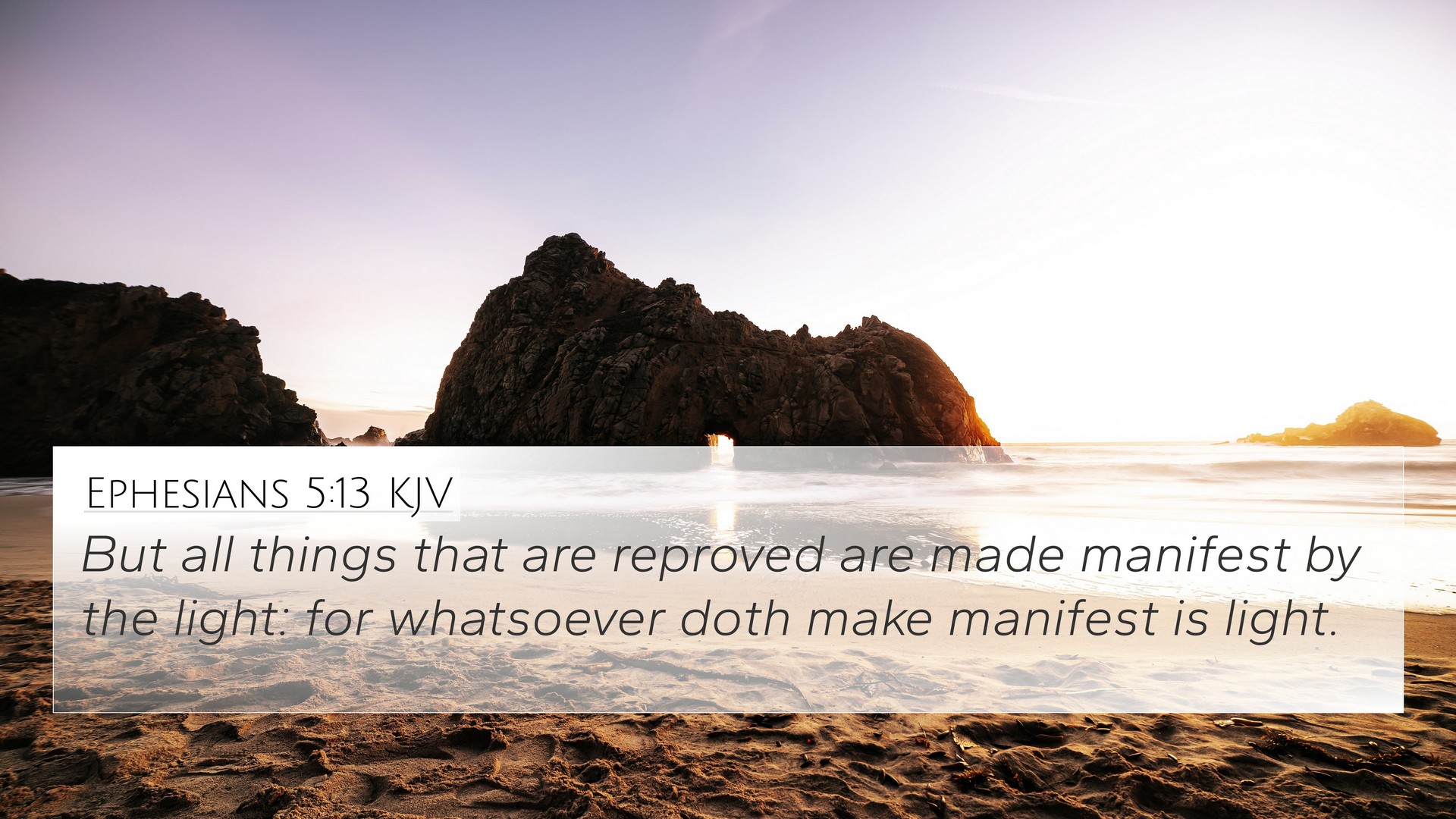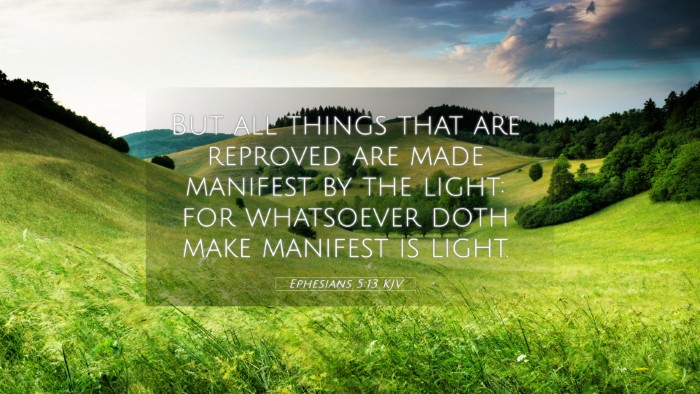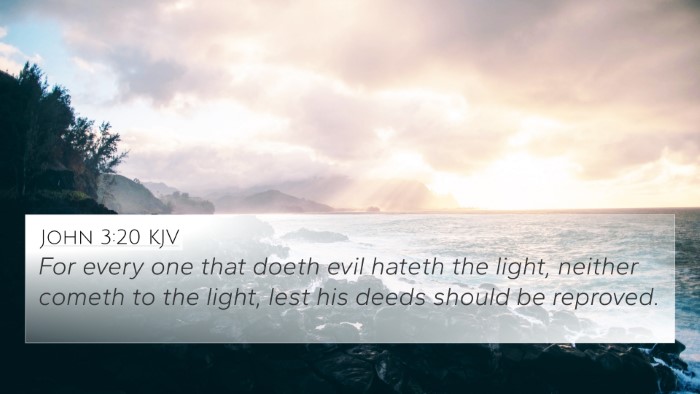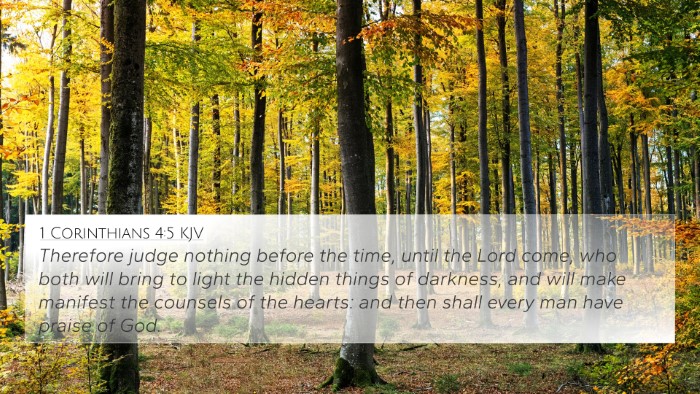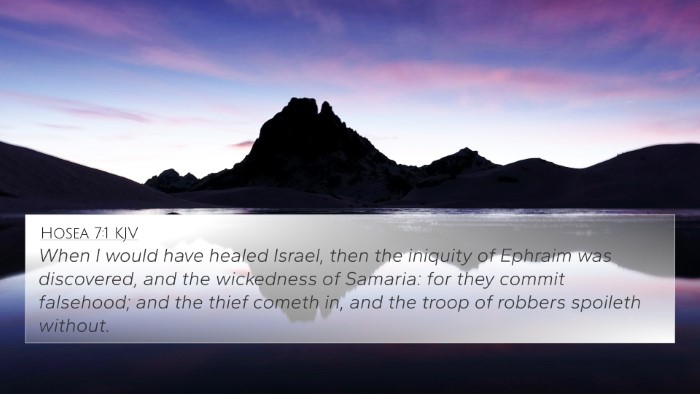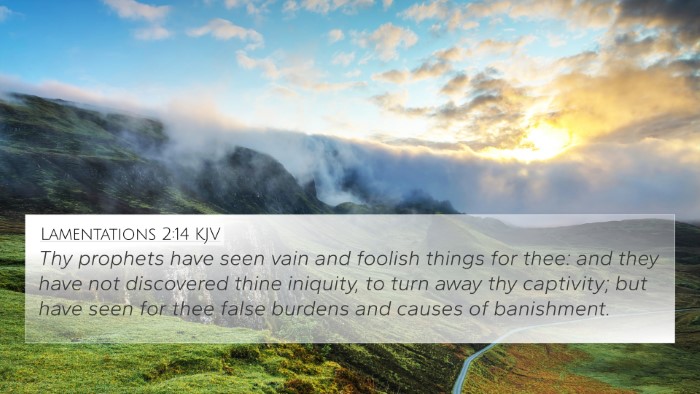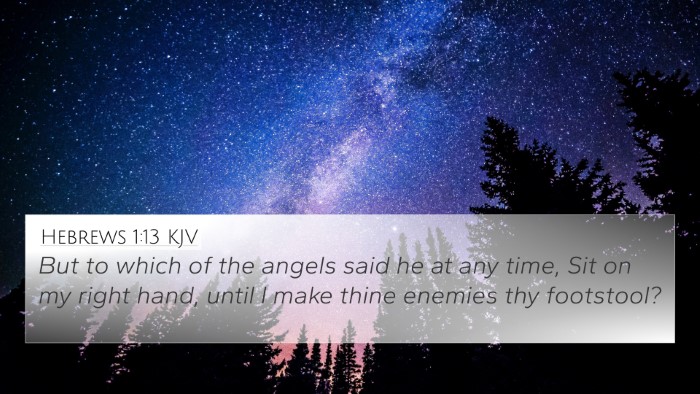Ephesians 5:13 - Summary of Meaning and Interpretation
Ephesians 5:13 is a profound verse in which the Apostle Paul expresses the transformative power of God's light and the significance of exposing deeds of darkness. The verse reads: "But all things that are exposed are made manifest by the light, for whatever makes manifest is light." This verse can be explored through the lens of various public domain commentaries, which help illuminate its meaning and significance in the Christian faith.
Understanding Ephesians 5:13
This section summarizes insights from notable public domain commentaries such as those by Matthew Henry, Albert Barnes, and Adam Clarke.
Insights from Commentators
- Matthew Henry: Henry emphasizes the contrast between light and darkness. He interprets the light as the truth of the Gospel which not only exposes sin but also transforms lives. The manifestation through light signifies the unveiling of hidden evils, illustrating the power of God’s truth to bring clarity to moral confusion.
- Albert Barnes: Barnes highlights that the exposure of deeds in the light serves to purge the darkness. He asserts that this manifestation is a call for believers to live in truth, as the light is representative of God’s holiness. The commentary points out that the implication of living in the light means to reject sin and embrace the righteousness of Christ.
- Adam Clarke: Clarke provides a linguistic analysis, contemplating the original Greek terms used in this passage. He suggests that the word "manifest" implies a revealing process that is ongoing; as believers walk in the light, they are continuously transformed and encouraged to expose deeds of darkness for what they are, thus clearing the way for divine truth.
Key Themes of Ephesians 5:13
Some essential themes include:
- The Nature of Light: Light represents purity, truth, and holiness, in contrast to the darkness of sin.
- Transformation: Exposure to light leads to transformation. Believers are called to examine their lives in light of God’s truth.
- Accountability: The verse reflects an expectation for believers to live transparently before God and each other.
- Hope and Redemption: The call to expose darkness is inherently a message of hope, showcasing that through Christ, transformation is possible.
Related Bible Cross References
Ephesians 5:13 is connected with several other passages that reinforce its message:
- John 1:5: "And the light shines in the darkness, and the darkness did not comprehend it." This verse complements the theme of light overcoming darkness.
- Romans 13:12: "The night is far spent, the day is at hand; therefore let us cast off the works of darkness, and let us put on the armor of light." Here, Paul urges an active rejection of darkness.
- 1 Thessalonians 5:5: "You are all children of the light and children of the day; we are not of the night nor of darkness." This emphasizes the identity believers have in light.
- 2 Corinthians 4:6: "For it is the God who commanded light to shine out of darkness, who has shone in our hearts to give the light of the knowledge of the glory of God in the face of Jesus Christ." This reinforces the idea of divine illumination.
- Philippians 2:15: "...that you may become blameless and harmless, children of God without fault in the midst of a crooked and perverse generation, among whom you shine as lights in the world." A call to embody the light in action.
- 1 John 1:5: "This is the message we have heard from Him and declare to you: God is light; in Him there is no darkness at all." This reiterates God's nature and the essential role of light in the believer's life.
- Psalm 27:1: "The LORD is my light and my salvation; whom shall I fear?" This connects light with safety and salvation, encouraging trust in God's illumination.
Thematic Bible Verse Connections
When exploring the broader context of Ephesians 5:13, one can identify numerous thematic connections in scripture:
- Comparative Study of Pauline Epistles: This verse resonates with themes in other letters by Paul, such as the call to righteousness in Galatians 5:22-23, where the fruits of the Spirit are contrasted against the works of the flesh, illustrating the outcomes of walking in the light.
- Links Between Old and New Testament: The imagery of light has profound roots in the Old Testament, such as in Isaiah 60:1, which beckons light to rise upon God’s people, establishing continuity in the biblical narrative regarding light and guidance.
- Cross-referenced Themes in the Bible: The integration of light and truth is also found in John 8:12, where Jesus declares, "I am the light of the world", indicating His role in leading others from darkness into the light of salvation.
Conclusion
In conclusion, Ephesians 5:13 serves as a powerful reminder of the responsibility of believers to live in the light, exposing darkness and embracing the transformative nature of God's truth. The connections and cross-references with other scriptures enhance the understanding of this verse, allowing for a richer and deeper study of Biblical themes.
